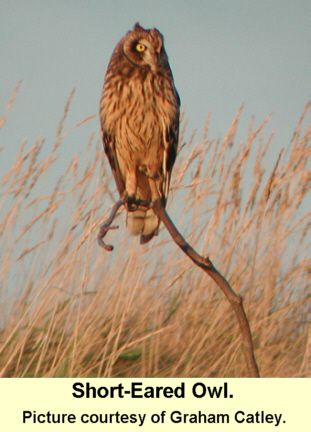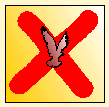
SHORT-EARED OWL. Asio
flammeus 
IDENTIFICATION. The Latin name flammeus means 'flame coloured', which is a description of the eyes rather than the plumage. The facial disc is a prominent pale 'mask' with a dark beak and pale yellow eyes set in dark feathers. A band of lighter brown feathers arc away from the eyes, occasionally giving the appearance of a clown like tear line. The chest has dark streaks over buff plumage. The back is buff and brown with streaks and bars. The wings are long and 'harrier' like when in flight. The wing tips and carpal patches are dark. The tail is short.
In flight commonly confused with female harriers.
IN FLIGHT. The Short-eared Owl has a quartering style of flight similar to harriers that is interspersed with hovering. The wings are held in a shallow V during the glide.
DISTRIBUTION. An owl of moorland, marsh and dune. In winter it moves southward from its hunting grounds in Scotland, Wales and the North and East of England to grazing land and marsh.
WHEN SEEN. All year round.
FOOD. Small mammals, mainly field voles, including shrews, rats and even small rabbits. Birds are also part of the Short-eared Owls diet, including sea gulls!
BREEDING. April-May. 4 to 14 eggs laid in a scrape in reeds, heather or grass which is defended vigorously. Young hatch after 3- 4 weeks, with the young leaving the nest at 2 weeks and flying at 3- 4 weeks.
SIZE. 38cm (15in)
CALL. boo-boo-boo
FALCONRY.
Not generally used in falconry. However if the short-eared owl is to be kept they need a good size aviary, not a parrot cage, and company if not flown regularly.
NB. If you buy one of these raptors it should be fitted with a closed leg ring and have an Article 10 form with it (any queries check with DEFRA).
Falconry marks
